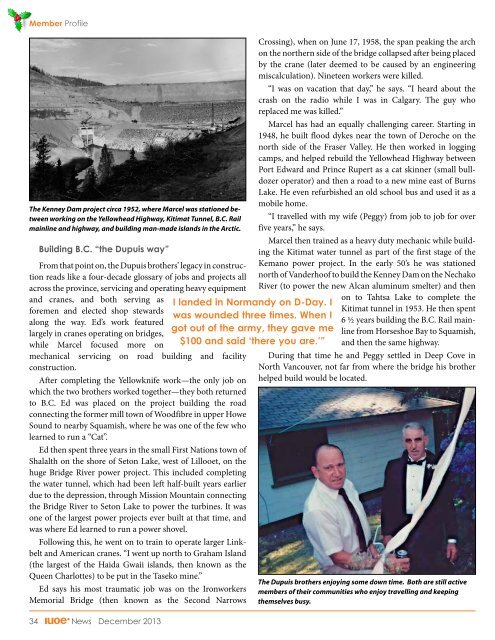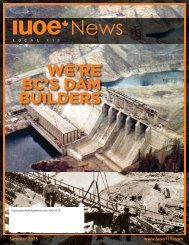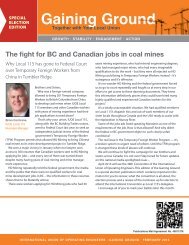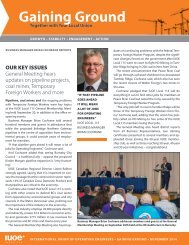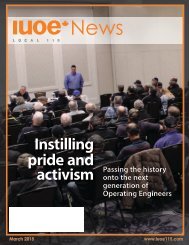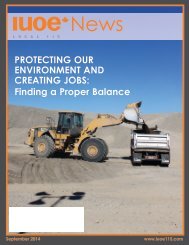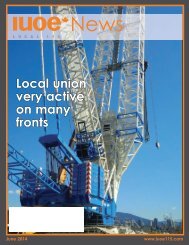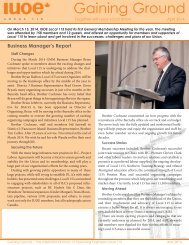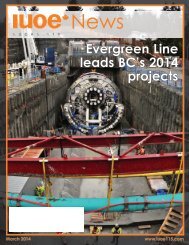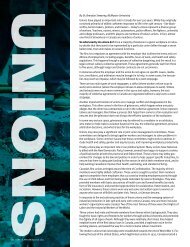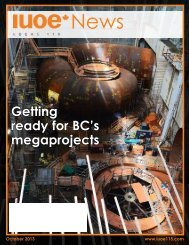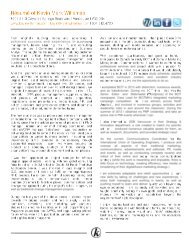IUOE News Winter 2013
The December 2013 issue of the OE News from IUOE Local 115 contains updates for all equipment operators and union supporters in BC. Enjoy!
The December 2013 issue of the OE News from IUOE Local 115 contains updates for all equipment operators and union supporters in BC. Enjoy!
You also want an ePaper? Increase the reach of your titles
YUMPU automatically turns print PDFs into web optimized ePapers that Google loves.
Member Profile<br />
The Kenney Dam project circa 1952, where Marcel was stationed between<br />
working on the Yellowhead Highway, Kitimat Tunnel, B.C. Rail<br />
mainline and highway, and building man-made islands in the Arctic.<br />
Building B.C. “the Dupuis way”<br />
From that point on, the Dupuis brothers’ legacy in construction<br />
reads like a four-decade glossary of jobs and projects all<br />
across the province, servicing and operating heavy equipment<br />
and cranes, and both serving as<br />
foremen and elected shop stewards<br />
along the way. Ed’s work featured<br />
largely in cranes operating on bridges,<br />
while Marcel focused more on<br />
mechanical servicing on road building and facility<br />
construction.<br />
After completing the Yellowknife work—the only job on<br />
which the two brothers worked together—they both returned<br />
to B.C. Ed was placed on the project building the road<br />
connecting the former mill town of Woodfibre in upper Howe<br />
Sound to nearby Squamish, where he was one of the few who<br />
learned to run a “Cat”.<br />
Ed then spent three years in the small First Nations town of<br />
Shalalth on the shore of Seton Lake, west of Lillooet, on the<br />
huge Bridge River power project. This included completing<br />
the water tunnel, which had been left half-built years earlier<br />
due to the depression, through Mission Mountain connecting<br />
the Bridge River to Seton Lake to power the turbines. It was<br />
one of the largest power projects ever built at that time, and<br />
was where Ed learned to run a power shovel.<br />
Following this, he went on to train to operate larger Linkbelt<br />
and American cranes. “I went up north to Graham Island<br />
(the largest of the Haida Gwaii islands, then known as the<br />
Queen Charlottes) to be put in the Taseko mine.”<br />
Ed says his most traumatic job was on the Ironworkers<br />
Memorial Bridge (then known as the Second Narrows<br />
34 <strong>News</strong> December <strong>2013</strong><br />
I landed in Normandy on D-Day. I<br />
was wounded three times. When I<br />
got out of the army, they gave me<br />
$100 and said ‘there you are.’”<br />
Crossing), when on June 17, 1958, the span peaking the arch<br />
on the northern side of the bridge collapsed after being placed<br />
by the crane (later deemed to be caused by an engineering<br />
miscalculation). Nineteen workers were killed.<br />
“I was on vacation that day,” he says. “I heard about the<br />
crash on the radio while I was in Calgary. The guy who<br />
replaced me was killed.”<br />
Marcel has had an equally challenging career. Starting in<br />
1948, he built flood dykes near the town of Deroche on the<br />
north side of the Fraser Valley. He then worked in logging<br />
camps, and helped rebuild the Yellowhead Highway between<br />
Port Edward and Prince Rupert as a cat skinner (small bulldozer<br />
operator) and then a road to a new mine east of Burns<br />
Lake. He even refurbished an old school bus and used it as a<br />
mobile home.<br />
“I travelled with my wife (Peggy) from job to job for over<br />
five years,” he says.<br />
Marcel then trained as a heavy duty mechanic while building<br />
the Kitimat water tunnel as part of the first stage of the<br />
Kemano power project. In the early 50’s he was stationed<br />
north of Vanderhoof to build the Kenney Dam on the Nechako<br />
River (to power the new Alcan aluminum smelter) and then<br />
on to Tahtsa Lake to complete the<br />
Kitimat tunnel in 1953. He then spent<br />
6 ½ years building the B.C. Rail mainline<br />
from Horseshoe Bay to Squamish,<br />
and then the same highway.<br />
During that time he and Peggy settled in Deep Cove in<br />
North Vancouver, not far from where the bridge his brother<br />
helped build would be located.<br />
The Dupuis brothers enjoying some down time. Both are still active<br />
members of their communities who enjoy travelling and keeping<br />
themselves busy.


